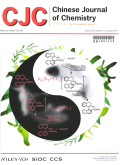- 钛学术文献服务平台 \
- 学术期刊 \
- 基础科学期刊 \
- 化学期刊 \
- 中国化学(英文版)期刊 \
null
Structure of AcMet-Gly and Its Interaction with Palladium(II)Tetraaqua Complex Studied by Electrospray Mass Spectrome try and Density Functional Theory
基本信息来源于合作网站,原文需代理用户跳转至来源网站获取
摘要:
The structure of dipepide AcMet-Gly was determined by X-ray crystallographic analysis. It possesses monoclinic, space group P21 (No. 4), with cell dimensions of a=0.8571(2) nm, b=0.5871(2) nm, c= 1.197(3) nm,β=99.290(10)°, V=0.5944(15) nm3, Z=2, .μ=2.74 cm-1. Mononuclear chelates, described as [Pd(X)(S,N,O-AcMet-Gly)] +, in which Pd(II) is coordinated by thioether, deprotonated amide nitrogen, carbonyl oxygen of methionine and X (AcMetGly or other ligands present in aqueous solution or in mobile phase solution), were detected 5 min after mixing AcMet-Gly with [Pd(H2O)4]2- at room temperature using electrospray ionization mass spectrometry. The geometry of [Pd(H2O)(S,N,O-AcMet-Gly)]+ is optimized at density functional B3LYP/LanL2DZ level. The fused five- and six-membered chelate is responsible for cleavage of Met-Gly bond. This is the first time to provide a direct evidence for Pd(II)-mediated cleavage of dipeptides via external solvent attack.

推荐文章
期刊_丙丁烷TDLAS测量系统的吸收峰自动检测
带间级联激光器
调谐半导体激光吸收光谱
雾剂检漏 中红外吸收峰 洛伦兹光谱线型
不同盐度、温度及光照对漂浮浒苔生理生态的影响
浒苔
盐度
温度
光照
生理生态
期刊_联合空间信息的改进低秩稀疏矩阵分解的高光谱异常目标检测
高光谱图像
异常目标检测 低秩稀疏矩阵分解 稀疏矩阵 残差矩阵
内容分析
关键词云
关键词热度
相关文献总数
(/次)
(/年)
引文网络
引文网络
二级参考文献 (0)
共引文献 (0)
参考文献 (0)
节点文献
引证文献 (0)
同被引文献 (0)
二级引证文献 (0)
2004(0)
- 参考文献(0)
- 二级参考文献(0)
- 引证文献(0)
- 二级引证文献(0)
引文网络交叉学科
相关学者/机构
期刊影响力
中国化学(英文版)
主办单位:
中国化学会
上海有机化学研究所
出版周期:
月刊
ISSN:
1001-604X
CN:
31-1547/O6
开本:
16开
出版地:
上海市枫林路354号
邮发代号:
4-646
创刊时间:
1983
语种:
eng
出版文献量(篇)
5429
总下载数(次)
0
总被引数(次)
8860
期刊文献
相关文献
推荐文献
- 期刊分类
- 期刊(年)
- 期刊(期)
- 期刊推荐
力学
化学
地球物理学
地质学
基础科学综合
大学学报
天文学
天文学、地球科学
数学
气象学
海洋学
物理学
生物学
生物科学
自然地理学和测绘学
自然科学总论
自然科学理论与方法
资源科学
非线性科学与系统科学
中国化学(英文版)2022
中国化学(英文版)2021
中国化学(英文版)2020
中国化学(英文版)2019
中国化学(英文版)2018
中国化学(英文版)2017
中国化学(英文版)2016
中国化学(英文版)2015
中国化学(英文版)2014
中国化学(英文版)2013
中国化学(英文版)2012
中国化学(英文版)2011
中国化学(英文版)2010
中国化学(英文版)2009
中国化学(英文版)2008
中国化学(英文版)2007
中国化学(英文版)2006
中国化学(英文版)2005
中国化学(英文版)2004
中国化学(英文版)2003
中国化学(英文版)2002
中国化学(英文版)2001
中国化学(英文版)2000
中国化学(英文版)2004年第9期
中国化学(英文版)2004年第8期
中国化学(英文版)2004年第7期
中国化学(英文版)2004年第6期
中国化学(英文版)2004年第5期
中国化学(英文版)2004年第4期
中国化学(英文版)2004年第3期
中国化学(英文版)2004年第2期
中国化学(英文版)2004年第12期
中国化学(英文版)2004年第11期
中国化学(英文版)2004年第10期
中国化学(英文版)2004年第1期

 免费查重
免费查重










